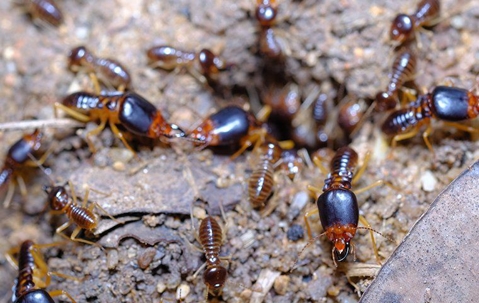When people think about termites, they usually think about termite season and the worker termites chewing away at the foundations of homes. Few people think about winged termites (known as swarmers) or the fact that termites are a year-round threat to their properties. By learning the truth about swarmers, you may unlock the key to termite prevention on your property. Plus, the more you learn about termites, the more you’ll realize why prevention is so important.
The Truth About Termite Season
Termite season reaches its peak in the springtime. Unfortunately, just because there’s a termite season doesn’t mean they stop existing during the other months of the year. It’s a lot like baseball. Just because it happens during the warm, summer months doesn’t mean that baseball players don’t exist in the other months of the year. Termite season simply refers to the best time for termites to recolonize. Swarmers, or winged termites in charge of recolonization, will fly around in large groups on a warm day following a few days of rain. That’s why they’re much more likely to create a colony on your property in the summertime. But worker termites are active year-round, 24 hours a day, seven days a week. Worker termites don’t even sleep! Many homeowners don’t realize that they have a termite problem since they don’t notice the worker termites until it’s too late. Failure to recognize the signs of an infestation can lead to thousands of dollars’ worth of damage in just a year-and-a-half. During the spring and summer months, you should keep an eye out for swarmers near any streetlamps close to your property or any light fixtures attached to the outside of the house. While spotting swarmers on your property is the easiest sign to notice, there are other signs you should keep an eye (or an ear) out for during the other months of the year:
- Mud tubes on the bottoms of your outdoor walls
- Tightening of doors and windows
- Faint clicking noises in the walls
- Visible damage to exposed wood in the basement or crawl space
If you notice any of these signs, get professional help immediately. Unfortunately, there is nothing you can do to completely eradicate a termite infestation yourself, which is another reason why preventing termites is so important.
The Truth About Termite Season
While you might not be able to get termites out of your house once they’re inside, you might be able to keep them from invading your house in the first place. First of all, you can avoid attracting swarmer termites onto your property by placing any outdoor lights away from the house, as they’ll typically congregate near these. However, swarmers are not talented fliers, so if they wind up on your property, they probably have a nest nearby. To make your yard less attractive to nesting termite, it all starts with moisture control. Most termites prefer to feed on wood that has already been exposed to moisture damage, so controlling moisture issues will be a great first step in reducing termite attraction. Start with the following methods:
- Place a dehumidifier in areas of poor ventilation, especially basements or crawlspaces.
- Monitor your pipes for leaks.
- Utilize gutters and downspouts to direct rain runoff away from the side of the house.
- Maintain the lawn regularly to allow moisture to disburse evenly and reduce clutter like leaves and sticks.
While all of these methods can be effective, none of them are guaranteed to work. If you want guaranteed termite prevention, it’s time to enlist professional help. Call Texas Star Pest & Termite for the services needed to protect your home. We can help!

